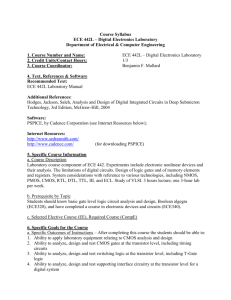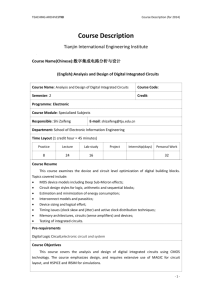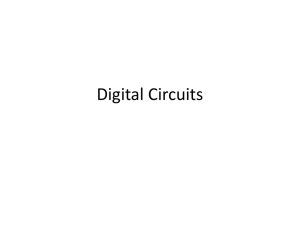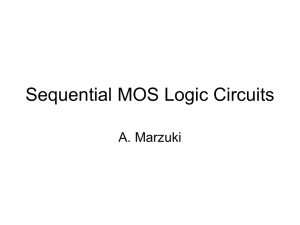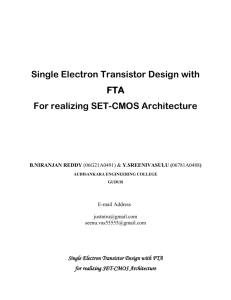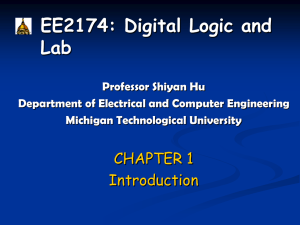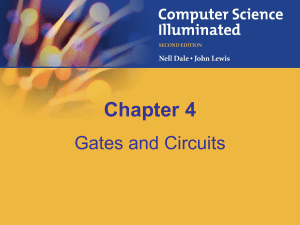Dynamic logic
advertisement
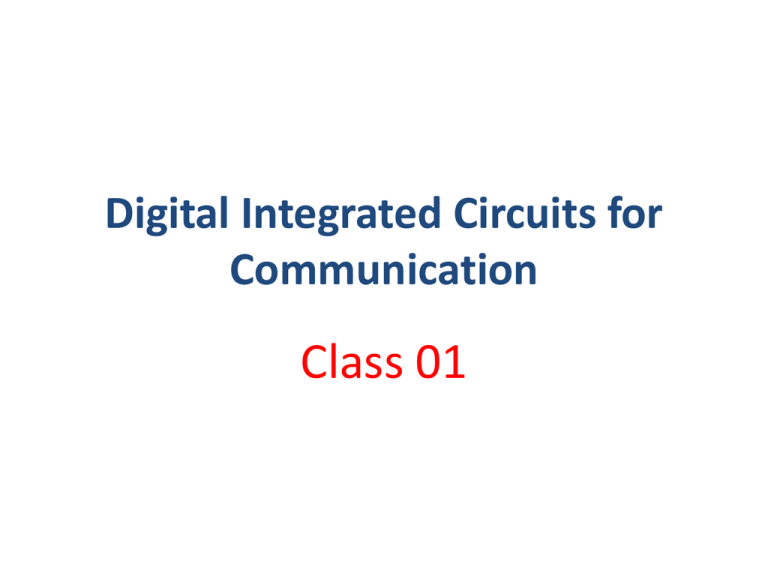
Digital Integrated Circuits for Communication Class 01 Course Contents • Dynamic CMOS design; dynamic logic: Basic principles, speed and power dissipation of dynamic logic, issues in dynamic design, cascading dynamic gates. • Static latches and registers; bistability principle; Course Contents • Multiplexer-based latches; low-voltage static latches; • Static SR Flip-Flops – writing data by pure force; • dynamic latches and registers; dynamic transmission; C2MOS – clock-skew insensitive approach; true single-phase clocked register (TSPCR); alternative register styles; Course Contents • Pulse registers, • Sense-amplifier based registers; pipelining: an approach to optimize sequential circuits; • Latch- vs. register-based pipelines; NORACMOS – logic style for pipelined structures; • Non-bistable sequential circuits; Schmitt trigger; monostable sequential circuits; astable circuits; Course Contents • Memory core; read-only memories; nonvolatile read-write memories; read write memories (RAM); • Contents-addressable or associative memory (CAM); memory peripheral circuitry; address decoders; sense amplifiers; Course Contents • Voltage references; drivers/buffers; timing and control; memory reliability and yield; • signal-to-noise ratio; memory yield; power dissipation in memories. Dynamic Logic Circuits • Dynamic logic is temporary (transient) in that output levels will remain valid only for a certain period of time – Static logic retains its output level as long as power is applied • Dynamic logic is normally done with charging and selectively discharging capacitance (i.e. capacitive circuit nodes) – Precharge clock to charge the capacitance – Evaluate clock to discharge the capacitance depending on condition of logic inputs * Kang and Leblebicic, chapter 9 R. W. Knepper SC571, page 5-55 Dynamic Logic • Advantages over static logic: – Avoids duplicating logic twice as both N-tree and P-tree, as in standard CMOS – Typically can be used in very high performance applications – Very simple sequential memory circuits; amenable to synchronous logic – High density achievable – Consumes less power (in some cases) • Disadvantages compared to static logic: – Problems with clock synchronization and timing – Design is more difficult Dynamic Logic • The largest difference between static and dynamic logic is that in dynamic logic, • a clock signal is used to evaluate combinational logic. • in dynamic logic, there is not always a mechanism driving the output high or low. In the most common version of this concept, the output is driven high or low during distinct parts of the clock cycle. Dynamic Logic • Dynamic logic requires a minimum clock rate fast enough that the output state of each dynamic gate is used before it leaks out of the capacitance holding that state, during the part of the clock cycle that the output is not being actively driven. Dynamic Logic • Dynamic logic, when properly designed, can be over twice as fast as static logic. It uses only the faster N transistors, which improve transistor sizing optimizations. • Static logic is slower because it has twice the capacitive loading, higher thresholds, and uses slow P transistors for logic. Dynamic Logic • Dynamic logic can be harder to work with, but it may be the only choice when increased processing speed is needed. • In general, dynamic logic greatly increases the number of transistors that are switching at any given time, which increases power consumption over static CMOS Dynamic Logic • The dynamic logic circuit requires two phases. The first phase, when Clock is low, is called the setup phase or the precharge phase and the second phase, when Clock is high, is called the evaluation phase. Dynamic Logic CLK Mp Out A Me Evaluate VOut Precharge Leakage sources Conditions on Output • Once the output of a dynamic gate is discharged, it cannot be charged again until the next precharge operation. • Inputs to the gate can make at most one transition during evaluation. • Output can be in the high impedance state during and after evaluation Dynamic Logic • CMOS Dynamic Two-Phase Flip-Flops Dynamic Logic • Disadv: 2 non-overlapping clocks required (4 if transmission gates are used • These implementations MUST be simulated at all process corners (under worst-case conditions). Dynamic Logic • Dynamic CMOS circuits rely on the temporary storage of signal values on the capacitance of high-impedance circuit nodes. • These circuits also have no static power dissipation and uses a sequence of precharge and conditional evaluation phases with the addition of a clock input. Dynamic Logic (Clock) Dynamic Logic • The main advantages of the Dynamic CMOS logic are increased speed and reduced implementation area. • Fewer devices are used to implement a given logic, this reduces the overall load capacitance and thus increases the speed. Static Logic • The speed of the static CMOS circuit depends on the transistor sizing and the various parasitics that are involved with it. Static Logic • A Static CMOS gate is a combination of two networks - the pull-up netowrk (PUN) and the pull-down network (PDN). • The function of the PDN is to provide a connection between the output and Vdd anytime the output of the logic gate is supposed to be 1. • Similarly, the PDN connects the output to Vss anytime the output is supposed to be 0. Static Logic • In Static CMOS design, at every point in time, each gate output is connected to either Vdd or Vss via a low-resistance path. • Also, the outputs of the gate assume at all times the value of the Boolean function implemented by the circuit. Static v.s. Dynamic • Static Logic Gates – Valid logic levels are steady-state operating points – Outputs are generated in response to input voltage levels after a certain time delay, and it can preserve its output levels as long as there is power. – All gate output nodes have a conducting path to VDD or GND, except when input changes are occurring. • Dynamic Logic Gates – The operation depends on temporary storage of charge in parasitic node capacitances. – The stored charge does not remain indefinitely, so must be updated or refreshed. This requires establishment of an update or recharge path to the capacitance frequently enough to preserve valid voltage levels. 24 Static v.s. Dynamic (Continued) • Advantages of Dynamic Logic Gates – Allow implementation of simple sequential circuits with memory functions. – Use of common clock signals throughout the system enables the synchronization of various circuit blocks. – Implementation of complex circuits requires a smaller silicon area than static circuits. – Often consumes less dynamic power than static designs, due to smaller parasitic capacitances. 25 Pass Transistor Logic Circuits nMOS Pass transistor – transmission properties Transmission Gates Transmission Gate Applications Mux XOR D Latch D Flip Flop Clock Skew management Pass Transistor Logic Families
